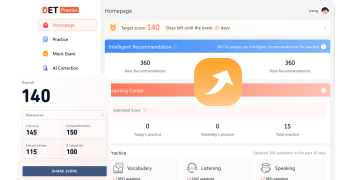轻松实现互动听力:轻松掌握全新DET题型的简单框架
大家好,欢迎来到DET练习。今天我们将讲解如何做“Interactive Listening”题型。不同于那些只给出泛泛建议的文章,我们会在本文中提供非常具体、可操作的建议和步骤。请认真阅读,相信这会帮助你在“Interactive Listening”部分获得更高分。让我们开始吧!
题型介绍
“Interactive Listening”是都灵英语测试(Duolingo English Test)在2023年推出,并于2025年更新的一种全新题型。在这一部分,你将依次遇到多个问题。主要有三种类型:
1. 听后填写:在这部分,你会听到一个简短的情景,需要填写3-4个句子的填空题。
2. 听后选择:本节为多项选择题,每题有4-5个答案选项。你有4分钟时间完成此部分。
3. 总结对话:此处要求你总结对话内容,答题时间为75秒。
如果你想进一步了解“Interactive Listening”,可以观看下方官方简短介绍视频(从约0:56开始):
另外,如果你更喜欢阅读文字版本,我们在另一篇文章中也有更详细的“Interactive Listening”介绍: https://www.detpractice.com/det-question-type-interactive-listening
注意:本指南已更新。你可以在这里查看最新版: 都灵英语测试“互动听力”——完整攻略(新版本)
Listen and Respond
与托福或雅思的听力题不同,DET中的“Interactive Listening”题目会逐步显示听力脚本。没错,你没看错。这意味着每当你作答一道题,就会出现之前的提示信息(好消息!)。
l 接下来我们来看看题目界面:
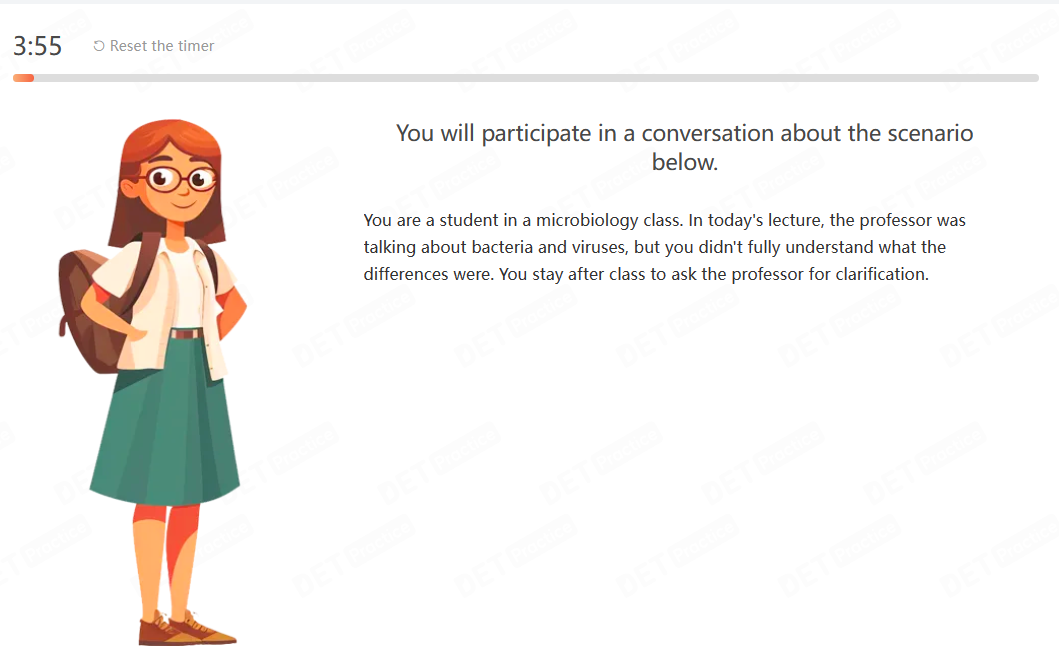
每次做“Listen and Respond”前,你都会看到如下的Scenario(场景介绍)。我们来分析一下这个Scenario能提供哪些信息:
a. 你将参与下面这个场景相关的对话。(注意,与传统的听力题不同,你作为考生将扮演对话中的其中一个角色。)
b. 你是一名微生物学课堂上的学生。(这说明了你的身份。)
c. 在今天的讲座结束后,你向教授询问了细菌和病毒的区别。(这里提及了你遇到的问题,以及你向谁寻求帮助或进行了讨论。)
此时我们可以理解,这个Scenario实际上也是某种形式的听力脚本摘要(后面还会继续说明)。因此,这一场景描述也可以用来作为判断“Listen and Respond”题目的依据。
l 让我们举一道题为例:
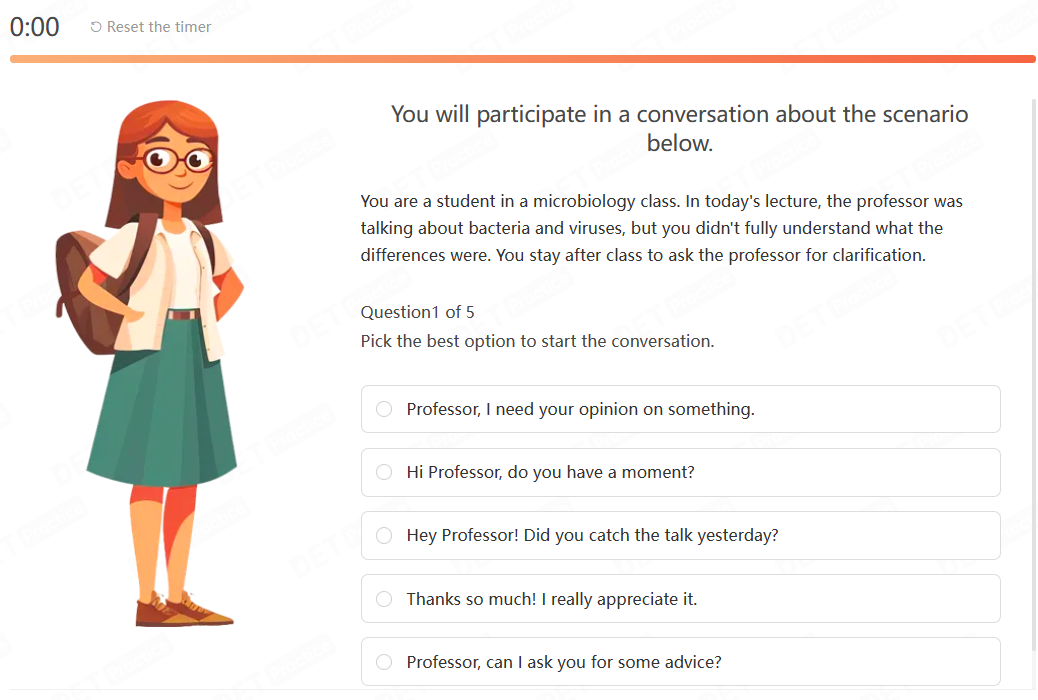
请快速回忆我们刚刚看到的Scenario。 这样只有第5选项才是最合适的答案。
l 让我们继续看下一题:
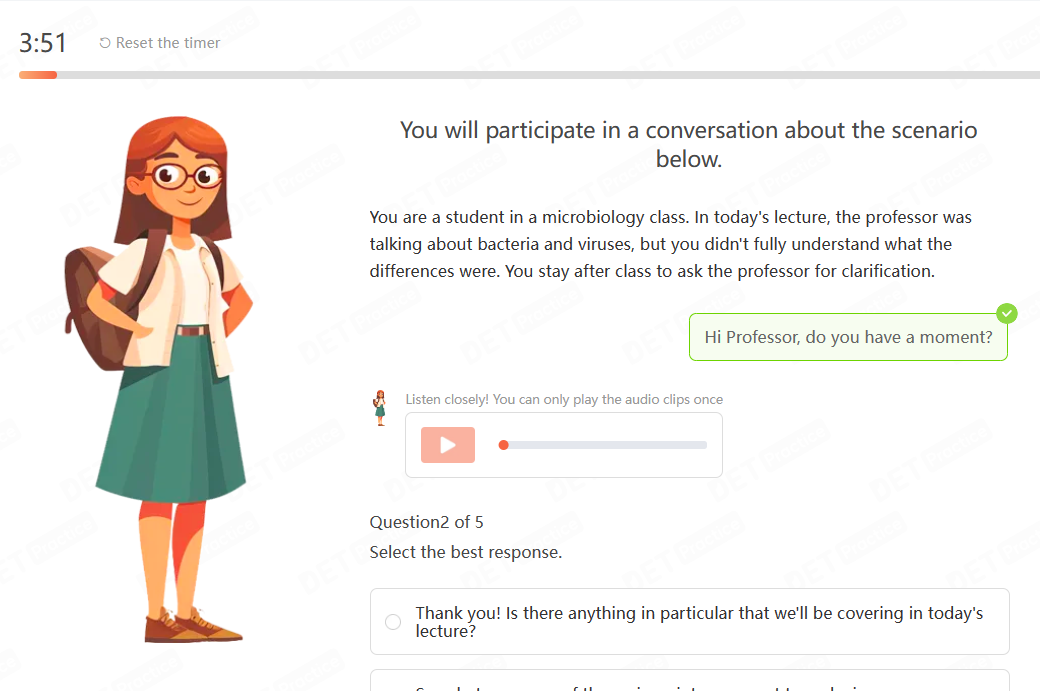
在这里可以看到,你之前的选择和听过的内容会被展示出来。这对考生来说很有帮助,使答题变得更容易。
那么我们如何做选择呢?还记得前面的Scenario吗?这些例子实际上展现了Scenario的作用以及后续脚本的信息,这些都能帮助你答接下来的选择题。
做完“Listen and Respond”部分后,你会看到所有听力脚本。如前文所述,通常还剩下1-2分钟时间,请利用这段时间通读文本并记住对话中的关键信息,因为难度最高的问题 “Summarize the Conversation,”即将到来。
Summarize the Conversation
首先,让我们来看题目界面:
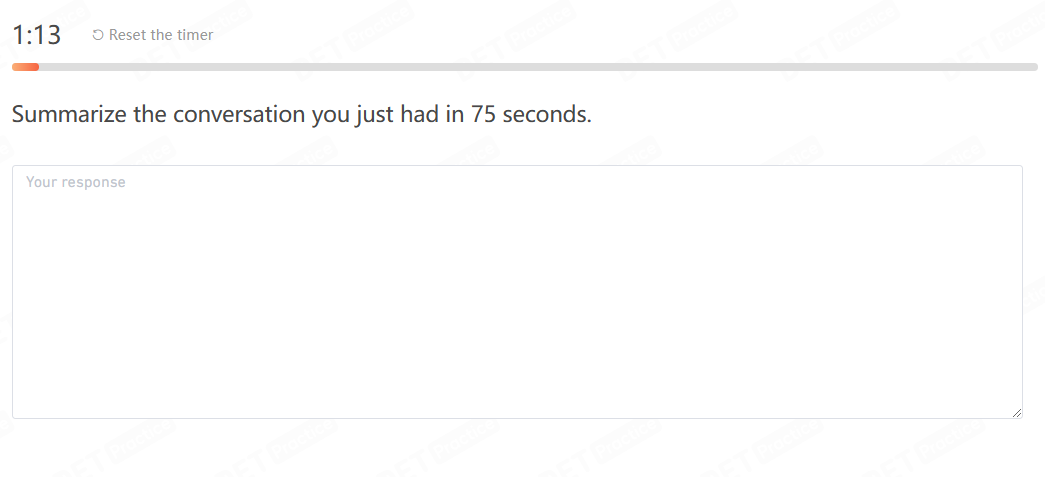
这是一个让人很紧张的界面。除了提示你本题只有75秒作答之外,其他什么都没有了。没错,你将无法再次看到之前的对话内容。所以只能凭记忆来写对话摘要。这题的难度在于它需要考生具备很强的短时记忆和打字速度。如何在这道题中尽量多得分?首先请注意以下几点细节:
1. 摘要写作应使用第一人称
2. 过去时和现在时会是最常用的时态
3. 写作时尽量涵盖对话里的细节
如果以上三点还有疑问,可以参考范文样例。

大多数考生的答题策略
l 如果你的短时记忆力不够好,或者词汇基础和听力能力都较弱,对对话内容不能完全理解,我们建议你以场景描述为主。这个Scenario其实是对听力内容的大致总结(虽然缺少一些细节)。在完成“Listen and Respond”后剩余的时间里,请重点记忆场景部分,并在后面的写作中尽量还原。当然,最好使用自己的表达方式而不是直接照搬原文。
l 如果你的打字速度不够快,建议你每天在 typing.com 或 keybr.com网站进行15-30分钟的打字练习。备考时间有限的考生,在考试前至少掌握一个“Interactive Listening”的写作模板框架,因为如果在75秒答题时还要临时思考结构,就无法写出足够的内容。
如果你的英语能力目前不是很理想,建议试试我们推荐的方法来备考或答题。祝你都灵英语考试顺利!
点击这里查看更多DET备考策略
现在就注册我们的DET题库 开始免费的练习吧。


